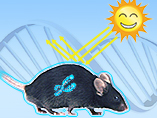
 Around 100 million people worldwide have red hair due to the variants of the melanocortin-1 receptor (MC1R) gene they carry. In addition to affecting hair color and skin pigmentation, red-hair-color (RHC) MC1R variants also significantly increase sun sensitivity and the risk of skin cancers such as melanoma. Until now we have known almost nothing about how MC1R is modulated by UV radiation, or how certain MC1R alleles increase the risk of skin cancer. But, in a recent paper, researchers seem to have finally found the elusive answer, and potentially also discovered new ways to prevent sun-induced melanoma.
Around 100 million people worldwide have red hair due to the variants of the melanocortin-1 receptor (MC1R) gene they carry. In addition to affecting hair color and skin pigmentation, red-hair-color (RHC) MC1R variants also significantly increase sun sensitivity and the risk of skin cancers such as melanoma. Until now we have known almost nothing about how MC1R is modulated by UV radiation, or how certain MC1R alleles increase the risk of skin cancer. But, in a recent paper, researchers seem to have finally found the elusive answer, and potentially also discovered new ways to prevent sun-induced melanoma.
Chen et al. found that MC1R undergoes a lipid modification called palmitoylation, and that this modification controls the development of melanoma. They used an impressive combination of mouse models, cell culture, and biochemical methods to elucidate a multistep pathway in which activation of ATR kinase by UV radiation leads to phosphorylation of the protein-acyl transferase ZDHHC13, which promotes MC1R-ZDHHC13 interaction, leading to palmitoylation and activation of MC1R.
Using a mouse model in which endogenous MC1R is truncated, Chen et al. expressed red-hair-color (RHC) variants of MC1R, and showed that a drug which inhibits depalmitoylation rescues the effects of RHC MC1R variants, thereby preventing melanoma when these mice are UV-irradiated. Not only could these findings potentially lead to life-saving cancer preventions, but this study may also represent the first example of palmitoylation stimulation being shown to prevent disease.
Cyagen Biosciences can help you harness the experimental power of animal models in your own research. We provide custom mouse and rat models, including transgenics, knockouts and knockins, Targeted Gene Editing and TALEN genome editing, as well as custom virus packaging, stem cells, and cell culture reagents. Our VectorBuilder platform allows you to design and order custom DNA constructs specific to your experimental needs. Choose from lentiviruses, adenovirus, AAV, shRNA expression vectors, Targeted Gene Editing vectors, and more
We will respond to you in 1-2 business days.